23.07.2004
A.Shashin. CHESS PLAN – FICTION OR REALITY? PART 2.
By discrediting chess plan, we also discredit the theory of positional game of Vilgelm Steinitz. It`s really so, but not the other way, as a chess plan is one of the pillars of this theory.
The epoch of the entire domination of the more than century-old "ideology" of Vilgelm Steinitz over the chess players` minds is coming to the end. Steinitz`s theory (it`s better to call it not theory, but a kind of pre-theory, i.e. forerunner of the "true" and future chess theory) lost its punch power. It is all-in and exhausted. The theory doesn`t answer modern scientific criteria. Steinitz`s theory is contradictory and infinitely far from mathematics.
Why? Or: what is the source of the gap between Steinitz`s theory and modern fundamentals of the chess game?
I`ll answer briefly and to the point: the chess game doesn`t fit into narrow bounds of classical scientific concepts. I`ll also add that when we describe chess system, it becomes necessary for us to supplement the traditional two-valued logic (with its classical "yes" and "no") with the new, third in numerical order logical valency!
...The first world chess champion originated his theory in the period of absolute hegemony of the classical concepts in the science. Newton`s physics explained practically "everything in the world" in those naïve times, which knew no doubts. Trifling problems at the periphery of science (radiation theory, electrodynamics...) were considered as temporary and easy to overcome. There reigned genuine optimism and belief in firmness of the established world order in science and social life.
Steinitz died at the turn of the century, in 1900. He didn`t live to see the twentieth century, the century of revolutionary upheavals, two world wars and severe crisis of the abstract science basis – mathematics and physics in the first place. In 1930s mathematicians had to abandon the illusion of formal and logical approach omnipotence (heavy blow!); at the same time physicians had to abandon "absolute" truths of Newton`s theory. It was rigorously proved by the methods of mathematics itself that mathematics as a science can`t be entirely derived from a certain consistent formal and logical system. A system can be of any complexity: mathematics doesn`t "fit" into it. Physicians had to introduce into physics the uncertainty principle under pressure of unexpected for them avalanche of experimental data. This principle became the fundamental one of the modern physics: it is impossible to measure absolutely precisely physical quantities!
Then Newton`s two-valued picture of outward things, which was before extremely clear – "yes" or "no" –, tumbled down. At once this picture became obscure and indefinite. The truth escaped to find a safe refuge in chaos. Outward picture became many-valued, "bifurcational" (see the theses at the end of the first part of the article).It was then when physicians began to worship His Majesty Chance.
Summary: "true" chess theory is coming...
2. Strategic middlegame.
I`ll start with an amazing example – a masterpiece of Nigel Short!
N.Short – Jan Timman
Tilburg, 1991.
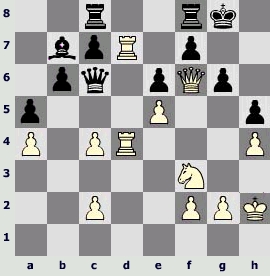
White won the game by the lunge of the King to the square g7!
32.¢g3 ¦ce8 33.¢f4 ¥c8 34.¢g5 1:0
Check-mate is inevitable after 34...¥d7 35.¢h6 .
What can I say?
It`s great!
However the masterpiece of Akiba Rubinstein, perhaps, is highly competitive in beauty with that of Nigel Short (see the diagram). But judge yourself...
А. Rubinstein – Е.Bogoliubov
Vienna, 1922.
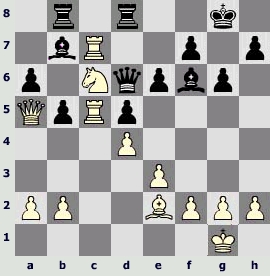
Here White made a move...
22.g3
I give the floor to Y.Razuvaev and V.Murakhvery – the authors of the book about the outstanding Polish chess player: "Looking at such moves one will feel a real super-class professional playing! A knack for making all the useful moves before forced operations significantly simplifies the realization of an advantage. The presence of a "window" is extremely important when opening a game."
And now here are some words on my behalf...
As it is known, a factor of King’s chess safety is only ... one of two-cipher number of the generally accepted chess position characteristics according to Steiniz. I repeat: a number of two ciphers! That`s why, playing a game, we can`t control accurately such "riches" all the time. As a rule, when we estimate a position during a game, we – chess players –control accurately only one characteristic, which is the dominating in the current position. Experience and intuition suggest which one to control. We don`t have the exact algorithm (heuristics!) of searching of the strongest move.
Besides, the problem of the strongest move searching during a game is aggravated by the fact, that the most of chess position characteristics are not defined precisely by Steiniz`s theory. We are infinitely far from mathematics, as it was already complained of.
Black is to move. Bogoliubov responded
22...¦dc8
It goes hard with Black. If 22...¥c6, then 23.¦5c6 with a guarantied destruction of the opponent`s queen side.
23.¤b8 ¦b8 24.¥b5 ¥d8
"24...ab5 would have been fatal considering 25.£a7" (S.Tartakover).
25.¥e8
An attack of the material target.
We have been already "studying" this – see the first part of the article.
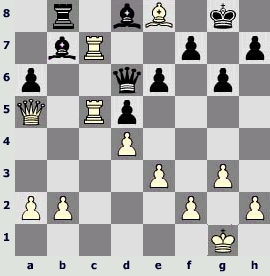
25...£f8
Or 25...¥c7 26.£c7 £c7 27.¦c7+-.
26.¦b7
Wins immediately.
26...¥a5 27.¦b8 £d6 28.¦b7 ¥b6 29.¦c6 £b4 30.¥f7
1 : 0
It`s one of the best games of Rubinstein...
There is a naïve question (remember, that the purpose of the article is the full-scale discredit of the chess plan): chess plan, where are you?
I don`t see it in this game. Having screwed up my short-sighted eyes, I can see only ingenious tactical squabble, which was forestalled by the single move of White, very strong move, victorious one 22.g3. Rubinstein moved upward his pawn and I see this quite clearly! He moved the pawn one file up. In other words, Rubinstein had shifted his position center of gravity vertically upward. It’s a displacement to the squares of pawn promotions and it`s minimal!
There is a question: Does the true nature of the strategic (positional) playing hide behind the back of this elementary act of the spatial chess expansion?
...I`m going on (sorry, one step backwards). Let us return to the fragment of the Short`s game. There is a question on the analogy: is the attack of the square g7, which is vitally important for Black (rush ¢h2 – h6!) a manifestation of the essence of the game of chess? White is moving the King up!
Yes or no?
Yes!
I`ll add: expansion is ... predetermined! Indeed, according to the chess rules pawns must move only upwards along the files, always in one direction. Pieces follow pawns and support them...
M.Botvinnik – V.Nenarokov
USSR, 1933
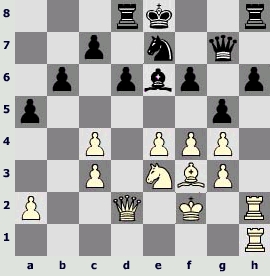
26.a3
It`s surprising! Botvinnik moves up the most insignificant of his pawns in the most "unmeaning" way (the pawn has no chance to become a queen and besides, it hasn`t approached not a jot the square of promotion after the move in the game. The pawn moves up almost instinctively, due to inertia of the military machine fly-wheel, moves up against the background of total moving up to the front line of all the reserves.
26...¢d7 27.£e2
White doesn`t hurry.
27...¦b8 28.£d3 ¢e8 29.¥d1 ¤g6
It`s better to move 29...¥d7, keeping the opponent`s Bishop from activating.
30.¥a4 ¢f8 31.¢f3
Moloch of the total expansion is inexorable.
31...¢g8 32.£d4
Last preparations
32...¦f8

33.¤f5
It`s a victorious, elaborately planned invasion into the opponent`s territory. Success is guaranteed, as White has advantage not only in chess time, but also in compactness of the position. Namely, White has both more mobility of his pieces and more packing density (the same compactness) of his forces at the attacked area.
33...¥f5 34.ef5 ¤e7 35.¥d7
Bishop is hurrying to the square e6.
35...¦h7 36.fg5 fg5
"Or 36...£g5 37.¦h5 £g7 38.g5 c5 (38..fg5 39.¥e6 ¢h8 40.¦h6) 39.¥e6 ¢h8 40.gh6 £g3 41.¢g3 cd4 42.cd4 ¤c6 43.¦5h4 etc.." (Botvinnik).
37.¥e6 ¦f7
If 37....¢h8, then 38.¦h6 with victory.
1 : 0
Any resistance is senseless after 38.£g7 ¢g7 39.¥f7 ¢f7 40.¦h6.
Botvinnik`s (victory)winning is an example of slow, careful and as if creeping expansion in strategic middlegame. Is expansion the key to success in the strategically best positions? Or, perhaps, expansion is something precious for us that we`ll later risk to raise to the rank of universal strategic plan?
Intuition, which was cherished by many years' experience, suggests: "yes!", "yes!" and "yes!" once again. Intuition is above logics and above mind...
There will be more explanations (we "explain" inspiration?!). I`m really embarrassed, but I`m also ... doomed. I`m doomed to continue my "explanations". They`ll be inevitable until mathematics, ignored by us, will be called for by us. We – chess players – are condemned to ineffective "verbosity" without mathematics (hard terms of Michail Ivanovich Chigorin!).
I ask you to pay special attention to comments on 42nd move of White in the last, the 4th in order game in that part of the article. It`s a brilliant victory of Anatoliy Karpov! The comment on the game as well asexpatiative postscript to it will bring us closer to the long-expected object. The discredit of the Chess plan will bring us to the idea about the inevitability of the failure of that idol – idol that goes back to the epoch of Vilgelm Steinitz.
Let’s replace Steiniz`s idol for "new" chess idol!
So be it. Amen.
А.Karpov – V.Unzicker
Nice, 1974, the Olympic Games.

37.¦a3
Probably almost obvious 38.¦1a2 was incorporated in a plan of White (plan or "plan"?) with the following exchange of Bishops at white squares + £a1 and ¥b6(¥e3). After that an exchange of a pair of Rooks + victorious invasion along the file "a" of two heavy pieces, which remain after the exchange of Rooks. It`s not vain, that Karpov moves up the Rook! A place for the Queen is the square a1.
37...¢f8 38.¦1a2
Am I a prophet?
38...¢g8
Black has nothing else to do, but to wait.
39.¤g4
This move may be regarded as an ingenuous and not fundamental specification of the proclaimed plan (plan or "plan"?). Karpov doesn’t hurry: the Knight at e3 takes up considerably better position.
39...¢f8
It`s bad 39...¥h5 40.¤h5 £h5. 41.¤f6 sobers up.
40.¤e3 ¢g8 41.¥f7
Is everything according to plan?
41...¤f7
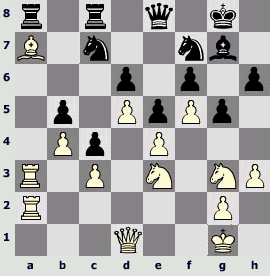
42.£h5
Thunderation!
It`s truly a surprising move that brings to a nonplus many conscientious "classical" commentators! Why, one may ask, White`s Queen invades the square h5, and not withdraws to the square that was prepared beforehand by the Rooks` manoeuvres? Or, if to suppose fondly, that the invasion to h5 was planned by Karpov already at 37th move or even earlier, the question arises, why White was doing those obviously superfluous for that action moves 37.¦a3 и 38.¦1a2? Why?
...Already Capablanka mentioned the fact (who did it before him?), that it`s expedient for player with better position not to hasten to start actions in positions that are strategically better. The psychological background of that practically valuable advice is obvious:the probability of error of weaker player increases every move (it`s more difficult to defend then to attack!?).
There is a question: is there any purely chess, objective background besides a psychological background?
I think it is. Or even: of course, it is! It`s real, because, as we know, objectively there are such chess positions, in which chess time factor is not decisive. If that is the case and not the contrary, then it`d be quite appropriate to ask ourselves one more new and plain question: may the player with stronger position spend this "extra" chess time in "free of charge" reinforcing of its own position?
The answer is obvious: yes! But how can one do this in practice?
Having pondered sensibly, we`ll come to a conclusion about necessity (expediency!?) of position reinforcing (modification!?) due to the expansion. Indeed, by moving the position up at the risk of nothing, we multiply chances of success: we`ll use all the pieces and pawns, as all our powers will have been moved up to the front line in the coming tactical squabble!
Let us, however, return to the game...
42...¤d8
Either 42...¤h8 43.¤g4 £h5 44.¤h5 ¢f7 45.¥b6 ¦a3 46.¦a3 ¦a8 47.¦a8 ¤a8 48.¥d8 or 48.¥a5 with victory (according to Karpov).
43.£g6 ¢f8 44.¤h5
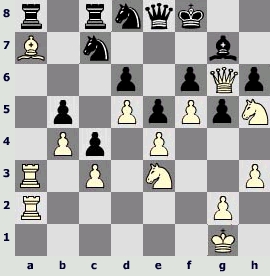
Whata dread!
White wins immediately after 44...£g6 45.fg6 and 46.¤f5 (who would have expected such a metamorphosis?)...
And now (attention, please: it`s very important!) I flagitate you, dear reader, to compare the position after 45.fg6 with the set of potentially possible chess positions after "planned" 42.£a1, 43.¥b6 etc.
Like day and dark! These are two absolutely different chess scenario! Aren`t they?
The answer is unambiguous! I`ll add: we are the witnesses ... of the chess point of bifurcation, the witnesses of "bifurcation" of chess plans. The system "takes" a decision in a random way. Kaissa, the goddess of the game of chess, throw dice: it fell out 42.£h5, and not 42.£a1. Is His Majesty Chance a faithful servant of God? Yesorno?
Slipping away from the tight embrace of the mind depraved by two-valued logic, chess truth takes safe refuge in the depths of uncertainty...
Is there the third logical valency?
1 : 0
...Here is a promised postscript. I`ll present it to you in the form of theses (see also the theses at the end of the first part of the article). There are five theses, five steps toward the goal. Attention, please!
1. His Majesty Chance (assume that we are "inside" a chaotic chess system) intricately mixes chess material. Initial chess position gradually "sprawls out" over the entire surface of the chess board. And the chess pieces themselves, i.e. white and black Kings, Queens, Rooks, Bishops and Knights, are being distributed over a chess board more or less evenly. The pawns are being gathered near the squares of chess promotions in view of their chess nature specificity.
In other words, spatial chess expansion is provided by the rules of the game at the "genetically" chess level.
2. Expansion becomes purposive in transfer from a chaotic chess playing to partially ordered one (purpose of the game is a check to opponent`s King). It accelerates. The reason of acceleration is an acquired "material incentive".
The pieces of the player with stronger position get into the opponent`s territory and attack material targets and strategically important free chess squares. The pawns "accelerate", as they dream of being Queens!
Spatial chess expansion becomes a total factor of the game during the attack.
3. Not only pieces and pawns, but also free chess squares have nonzero value. Free chess squares are full-fledged participants of the bifurcation process.
4. An average statistical chess value of free chess squares is less (far less) than that of pieces. That`s why the intensity of interaction of free squares with the squares that are occupied with pieces is less (far less) than the intensity of interaction between pieces.
Strategic playing is the way of playing when interactions of pieces with free squares predominate. While in combinational playing interactions between pieces predominate. That`s why frequency of bifurcation point`s appearance is small in strategically determined positions, when chess system is "sliding" along "the line of least resistance". Hence is a temptation of long-range planning.
5. Chess plan (according to Steiniz) is only a fragment of more flexible theoretical construction. Steiniz "works" perfectly, in situations without bifurcation points. Steiniz`s theory is powerless when they need to be taken in consideration.
To be continued...
References:
1) Y.S.Razuvaev, V.I.Murakhvery " Akiba Rubinstein". Moscow, "Physical culture and sport", 1980.
2) A.Shashin "Strategic middlegame". "Chess Petersburg" N2(12), 1999.
3) A.Shashin "Transparent parallels: Karpov and Capablanka". "Chess Petersburg", special issue, September, 2001.
4) A.Karpov "A hundred of victorious games". Moscow, "Physical culture and sport", 1984.
